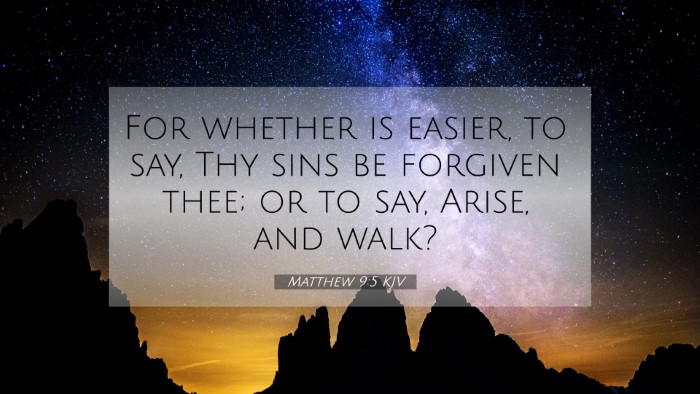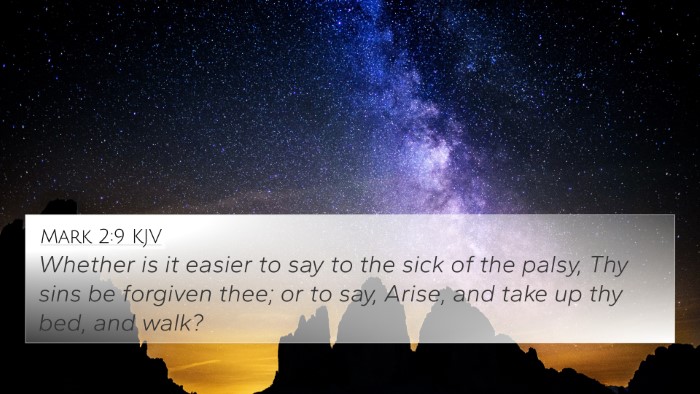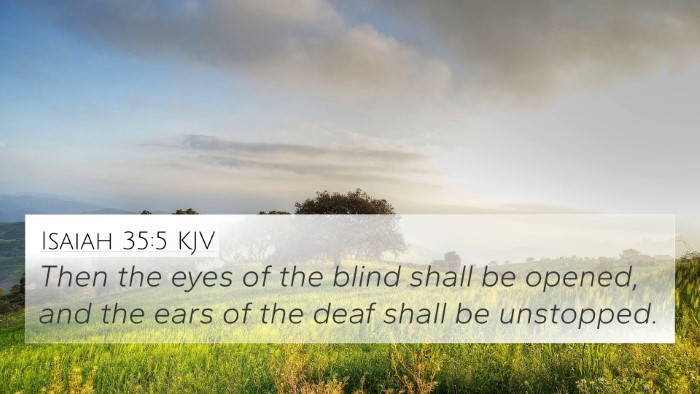Understanding Matthew 9:5
Matthew 9:5 states, "For whether is easier, to say, Thy sins be forgiven thee; or to say, Arise, and walk?" This verse presents a significant moment in Christ's ministry where He addresses the spiritual and physical healing of a paralytic man. The verse is pivotal in highlighting Christ's authority and the profound connection between sin and suffering.
Thematic Insights
This verse invites readers to consider the connections between Bible verses that showcase God's power to forgive sins and heal. Here are some thematic insights derived from public domain commentaries:
- Authority of Christ: Jesus emphasizes His divine authority as the Son of God, implying that both forgiveness and healing are within His capability (John 10:30).
- Spiritual and Physical Healing: The verse points towards the intertwined nature of physical ailments and spiritual conditions, reminding believers that healing encompasses both aspects (James 5:15).
- Faith of the Paralytic: The faith exhibited by the paralytic and his friends is essential, suggesting that God responds to genuine faith (Mark 2:5).
- Human Perspective vs. Divine Perspective: The rhetorical question posed by Jesus invites deeper introspection about human understanding compared to divine wisdom (Isaiah 55:8-9).
Cross-References and Biblical Connections
Matthew 9:5 can be understood through various relevant scripture passages that provide a broader context, bridging the connections between various Biblical texts:
- Isaiah 53:5: "But he was wounded for our transgressions, he was bruised for our iniquities: the chastisement of our peace was upon him; and with his stripes, we are healed."
- Mark 2:9: "Whether is it easier to say to the sick of the palsy, Thy sins be forgiven thee; or to say, Arise, and take up thy bed, and walk?"
- Luke 5:23: "Whether is easier, to say, Thy sins be forgiven thee; or to say, Rise up and walk?"
- John 5:14: "Afterward Jesus findeth him in the temple, and said unto him, Behold, thou art made whole: sin no more, lest a worse thing come unto thee."
- Psalms 103:3: "Who forgiveth all thine iniquities; who healeth all thy diseases."
- Acts 10:38: "How God anointed Jesus of Nazareth with the Holy Ghost and with power: who went about doing good, and healing all that were oppressed of the devil; for God was with him."
- James 5:16: "Confess your faults one to another, and pray one for another, that ye may be healed. The effectual fervent prayer of a righteous man availeth much."
Comparative Analysis
The linking of Matthew 9:5 with the aforementioned verses allows us to see a comparative Bible verse analysis that emphasizes Jesus’ dual role as both healer and forgiver. Believers can appreciate the comprehensive nature of Jesus Christ's work and how it ties to His identity as the Messiah. Here are further insights:
- Forgiveness First: The priority of spiritual healing before physical restoration suggests a theological principle that our relationship with God is paramount (Mark 2:5).
- Faith is Fundamental: Each account emphasizes faith as a catalyst for healing, illustrating the efficacy of belief in the works of Christ (Luke 7:50).
- The Nature of God’s Love: These scriptures collectively express a God who cares about the entirety of human experience, from sin to physical suffering (Romans 8:32).
Tools for Understanding Cross-References
To deeply analyze Bible verse parallels and study how verses relate, consider employing various tools for Bible cross-referencing. Resources such as a bible concordance or bible cross-reference guide can help uncover hidden connections and enrich your understanding of scripture.
Conclusion
In Matthew 9:5, Jesus illustrates profound truths about His identity and mission. He demonstrates not only His divine authority to forgive sins but also the connection between faith and healing. This verse serves as an endpoint for rich theological reflection and inter-Biblical dialogue that encourages believers to seek holistic understanding through scriptural cross-referencing.












